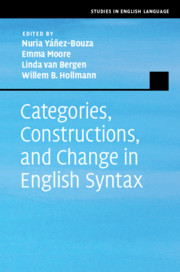Book contents
- Categories, Constructions, and Change in English Syntax
- Studies in English Language
- Categories, Constructions, and Change in English Syntax
- Copyright page
- Contents
- Figures
- Tables
- Contributors
- Acknowledgements
- Introduction: Analysing English Syntax Past and Present
- Part I Approaches to Grammatical Categories and Categorial Change
- Chapter 1 What Is Special about Pronouns?
- Chapter 2 What For?
- Chapter 3 Whatever Happened to Whatever?
- Chapter 4 Are Comparative Modals Converging or Diverging in English? Different Answers from the Perspectives of Grammaticalisation and Constructionalisation
- Chapter 5 The Definite Article in Old English: Evidence from Ælfric’s Grammar
- Part II Approaches to Constructions and Constructional Change
- Part III Comparative and Typological Approaches
- References
- Index
Chapter 4 - Are Comparative Modals Converging or Diverging in English? Different Answers from the Perspectives of Grammaticalisation and Constructionalisation
from Part I - Approaches to Grammatical Categories and Categorial Change
Published online by Cambridge University Press: 07 October 2019
- Categories, Constructions, and Change in English Syntax
- Studies in English Language
- Categories, Constructions, and Change in English Syntax
- Copyright page
- Contents
- Figures
- Tables
- Contributors
- Acknowledgements
- Introduction: Analysing English Syntax Past and Present
- Part I Approaches to Grammatical Categories and Categorial Change
- Chapter 1 What Is Special about Pronouns?
- Chapter 2 What For?
- Chapter 3 Whatever Happened to Whatever?
- Chapter 4 Are Comparative Modals Converging or Diverging in English? Different Answers from the Perspectives of Grammaticalisation and Constructionalisation
- Chapter 5 The Definite Article in Old English: Evidence from Ælfric’s Grammar
- Part II Approaches to Constructions and Constructional Change
- Part III Comparative and Typological Approaches
- References
- Index
Summary
In the last few years several papers have appeared on the synchrony and diachrony of the ‘comparative modal’ (had/‘d) better, inspired by Denison and Cort (2010), which pays particular attention to the rise of ‘bare’ better, as in You better go. Van der Auwera et al. (2013) provide extensive statistical analysis of British and American usage of ‘d better and its variants.
- Type
- Chapter
- Information
- Categories, Constructions, and Change in English Syntax , pp. 105 - 129Publisher: Cambridge University PressPrint publication year: 2019
- 1
- Cited by

